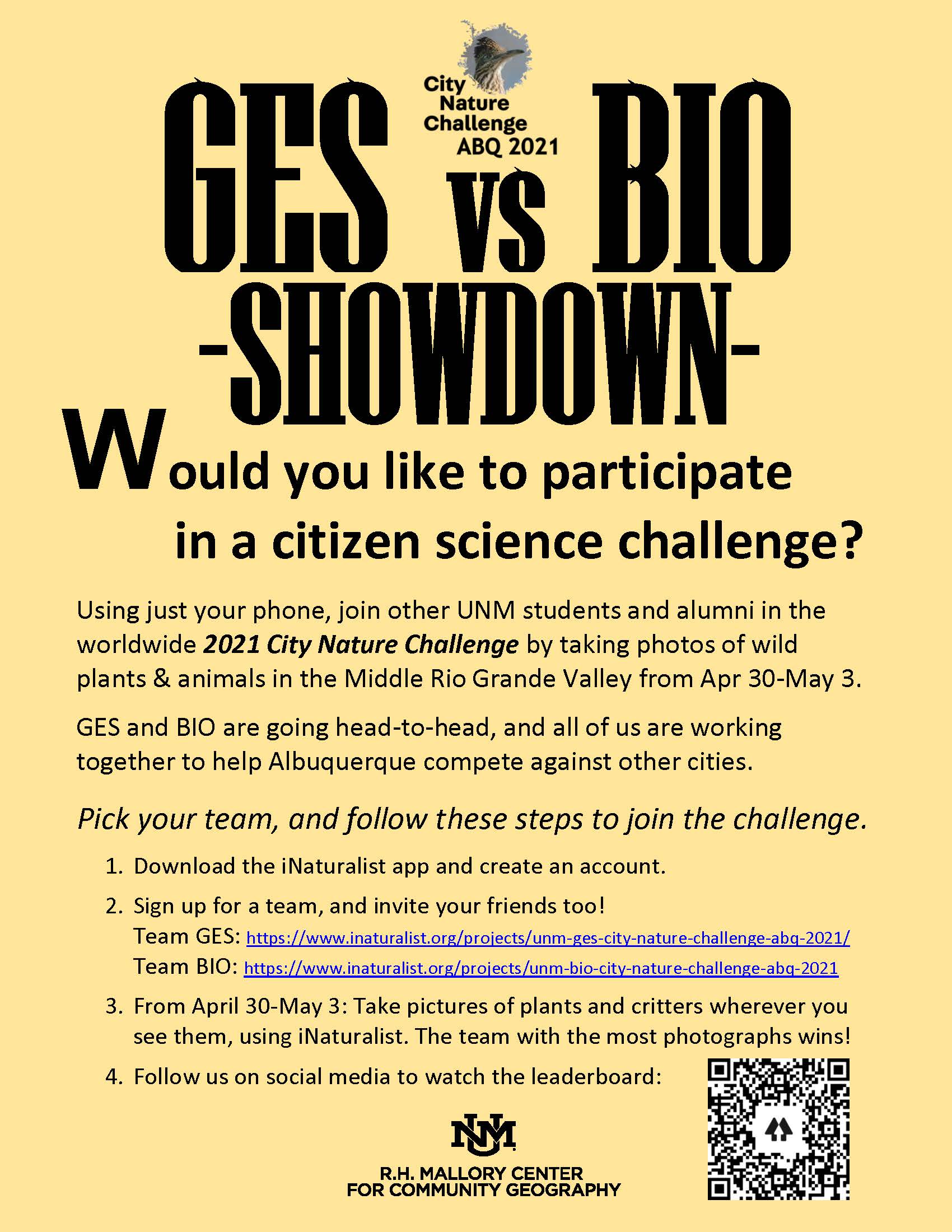GES challenges Biology Department in 2021 City Nature Challenge
 BREAKING: Two key departments at UNM have formed teams to compete in the 2021 City Nature Challenge. On Thursday, April 22, the Department of Geography & Environmental Studies (GES) challenged the Department of Biology to see which team can get the most participation and document the most wildlife observations between April 30 – May 3.
BREAKING: Two key departments at UNM have formed teams to compete in the 2021 City Nature Challenge. On Thursday, April 22, the Department of Geography & Environmental Studies (GES) challenged the Department of Biology to see which team can get the most participation and document the most wildlife observations between April 30 – May 3.
“We thought a ‘GES vs BIO Showdown’ would be a fun way to recruit participants for citizen science,” said Geography Professor Maria Lane. “Biology has a bigger department than we do, but we think we have a good chance to win if all our students and alumni join our team.”
Biology Professor David Hanson said he is looking forward to the challenge, and he encouraged all Biology faculty and students to join the effort to photograph plants and animals. “The more people that participate, the more data we will generate, which is great for all of us.”
The two departmental teams will compete in three categories: total number of plant/animal observations, total number of different species observed, and percent participation among each department’s faculty, grad students, and undergrad majors. The Center for Community Geography will announce final results via social media after May 9.
What is the City Nature Challenge?
The City Nature Challenge is a worldwide citizen science event focused on documenting urban wildlife using the iNaturalist mobile app. From April 30 to May 3, cities around the globe will compete/collaborate to observe and photograph plants and animals to see who can get the most participation and make the most observations. Once naturalists and scientists review and confirm the photographs, dataset are then made available to scientists and communities for use in mapping and other analysis.
Albuquerque has been competing in CNC since 2019 and this year is facing a direct challenge from Phoenix and Tucson. UNM students are encouraged to join Team BIO or Team GES to help our city come out on top! Whatever the outcome of the challenge, we’ll all be contributing to citizen science and providing data about biodiversity in the Middle Rio Grande region.
How do I Join a Team?
All UNM students are invited to join the challenge on one of the two teams. Follow these easy steps to get set up:
- Download the iNaturalist app to your phone.
- Join a team at UNM to make sure your observations are counted:
Team GES: https://www.inaturalist.org/projects/unm-ges-city-nature-challenge-abq-2021/
Team BIO: https://www.inaturalist.org/projects/unm-bio-city-nature-challenge-abq-2021
- From April 30 to May 3, make as many observations as possible in Bernalillo, Sandoval, or Valencia Counties. You don’t even have to know what you’re observing. Just take a photo and then the naturalists and scientists using iNaturalist will figure out what it is.
What if I’ve Never Observed Wildlife Before?
You don’t have to be an expert to contribute! Simply take photos of any plants or animals you see, even in your own backyard, and upload them to iNaturalist. The app is easy to use, and there are numerous training sessions available:
- Sign up for live ABQ City Nature Challenge iNaturalist tutorial (via Zoom)
- Watch this video: Finding Observations for iNaturalist in Your Neighborhood (8 minutes)
- Watch recorded iNaturalist tutorial (YouTube, 1h20min)
What happens after the City Nature Challenge?
After the observation period ends, expert naturalists and scientists will use iNaturalist to review all the photographs and ID all the species. Each team has until May 9 to complete the identification process before results are finalized and a winner is declared for each category. The identification process will take place simultaneously all across Albuquerque and around the world. Finalized datasets can be used later for mapping and analysis of biodiversity in our communities. The Center for Community Geography is currently working with the Albuquerque Backyard Refuge Program to use CNC data for mapping and planning/prioritizing community habitat restoration, so we hope to see as much participation as possible right here in New Mexico.

